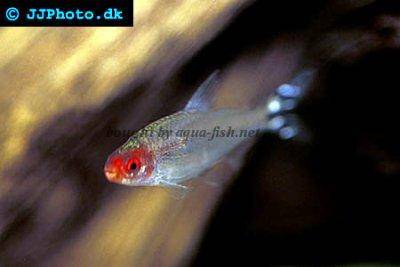False rummynose tetra - Petitella georgiae
Scientific name: Petitella georgiae
Common name: False rummynose tetra
Family: Characidae
Usual size in fish tanks: 4 - 5 cm (1.57 - 1.97 inch)
014
Recommended pH range for the species: 5.5 - 7
Recommended water hardness (dGH): 5 - 12°N (89.29 - 214.29ppm)
0°C 32°F30°C 86°F
Recommended temperature: 22 - 26 °C (71.6 - 78.8°F)
The way how these fish reproduce: Spawning
Where the species comes from: South America
Temperament to its own species: peaceful
Temperament toward other fish species: peaceful
Usual place in the tank: Middle levels
Food and feeding
False rummynose tetras are omnivores and do well on a high-quality flake or micro pellet staple. Their diet should be regularly supplemented with live or frozen foods such as brine shrimp, daphnia, or tubifex worms to maintain good health and coloration. Feed them in small portions 1–2 times a day, and always remove uneaten food to maintain water quality.
Origin
Petitella georgiae is native to South America and inhabits whitewater tributaries in the Amazon River basin, particularly in Peru. They are typically found in well-oxygenated, slow-flowing waters with soft, acidic conditions and dense aquatic vegetation.
Sexing
Sexing this species can be difficult. Generally, females are slightly plumper, especially when gravid, while males tend to be slimmer and may show slightly more intense coloration during breeding periods.
Breeding
Breeding Petitella georgiae requires soft, acidic water (pH 5.5–6.5) and subdued lighting. Avoid alkaline water, as it can affect fertility. Use a separate breeding tank with fine-leaved plants or spawning mops. Eggs are scattered and not guarded by parents, so the adults should be removed after spawning. The eggs hatch after about 30 hours, and fry become free-swimming within a few days. Feed the fry infusoria or liquid fry food at first, then transition to newly hatched brine shrimp.
Lifespan
False rummynose tetras typically live for 3 to 5 years with proper care, stable water conditions, and a stress-free environment.
Short description
The false rummynose tetra (Petitella georgiae) is a small, peaceful schooling fish known for its striking red facial markings and distinctive black-and-white tail pattern. Though often confused with true rummynose tetras (Hemigrammus rhodostomus), they are a separate species with similar behavior. Due to their sensitivity, they require pristine water quality and are best kept in established, well-maintained aquariums. A group of 6 or more individuals will feel more secure and display more natural schooling behavior. Subdued lighting, floating plants, and soft, acidic water will help mimic their natural habitat.
Suitable tankmates
False rummynose tetras are peaceful and do best in a calm community setup with other softwater-loving species. Ideal tankmates include:
- Neon tetras
- Ember tetras
- Pygmy corydoras
- Honey gouramis
- Otocinclus
- Other peaceful South American species requiring similar water conditions
Recommended plants
Planting the aquarium helps reduce stress and provides natural hiding places. Suitable plant choices include:
- Amazon sword (Echinodorus spp.)
- Java moss
- Cryptocoryne wendtii
- Floating plants such as Salvinia or Frogbit
- Anubias nana
Pictures
Bought by aqua-fish.net from jjphoto.dk.



 Bloodfin
Bloodfin  Bloodfin
Bloodfin  Panda
Panda  Green
Green  Blind
Blind  Kennedy
Kennedy  Blue
Blue  Discus
Discus  Pink
Pink  Bucktoothed
Bucktoothed  Black
Black  False
False  Silver
Silver  Hemigrammus
Hemigrammus  Dash-dot
Dash-dot  Rummy
Rummy  Glowlight
Glowlight  January
January  Head
Head  Garnet
Garnet  Rummy
Rummy  Gold
Gold  Red
Red  Ember
Ember  Buenos
Buenos  Colombian
Colombian  Columbian
Columbian  Bleeding
Bleeding  Flame
Flame  Georgett’s
Georgett’s  Griems
Griems  Kitty
Kitty  Black
Black  Firefin
Firefin  Loreto
Loreto  Black
Black  Lemon
Lemon  Redback
Redback  Rosy
Rosy  Serpae
Serpae  Savanna
Savanna  Red
Red  Blue
Blue  Silver
Silver  Ceros
Ceros  Napo
Napo  Diamond
Diamond  Red
Red  Rainbow
Rainbow  Emperor
Emperor  Cardinal
Cardinal  Neon
Neon  Green
Green  Glass
Glass  X-ray
X-ray  Penguin
Penguin